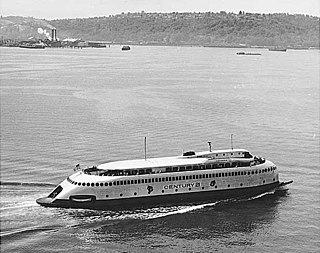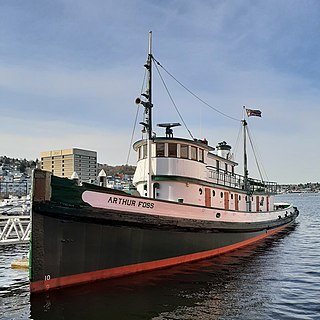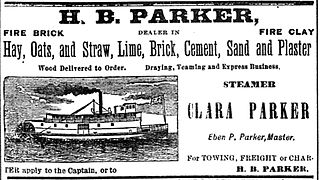
Motor Vessel Kalakala was a ferry that operated on Puget Sound from 1935 until her retirement in 1967.

Arthur Foss, built in 1889 as Wallowa at Portland, Oregon, is likely the oldest wooden tugboat afloat in the world. Its 79-year commercial service life began with towing sailing ships over the Columbia River bar, and ended with hauling bundled log rafts on the Strait of Juan de Fuca in 1968. Northwest Seaport now preserves the tug as a museum ship in Seattle, Washington.

Wide West was a steamboat that served in the Pacific Northwest of the United States. It had a reputation as a luxury boat of its days.

Many steamboats operated on the Columbia River and its tributaries, in the Pacific Northwest region of North America, from about 1850 to 1981. Major tributaries of the Columbia that formed steamboat routes included the Willamette and Snake rivers. Navigation was impractical between the Snake River and the Canada–US border, due to several rapids, but steamboats also operated along the Wenatchee Reach of the Columbia, in northern Washington, and on the Arrow Lakes of southern British Columbia.

The Bailey Gatzert was a sternwheel steamboat that ran on the Columbia River and Puget Sound from the 1890s to the 1920s. This vessel was considered one of the finest of its time. It was named after Bailey Gatzert, an early businessman and mayor of Seattle, who was one of the closest friends and business associates of John Leary – the person who financed the ship.

Lake Washington steamboats and ferries operated from about 1875 to 1951, transporting passengers, vehicles and freight across Lake Washington, a large lake to the east of Seattle, Washington. Before modern highways and bridges were built, the only means of crossing the lake, other than the traditional canoe or rowboat, was by steamboat, and, later, by ferry. While there was no easily navigable connection to Puget Sound, the Lake Washington Ship Canal now connects Lake Washington to Lake Union, and from there Puget Sound is reached by way of the Hiram M. Chittenden Locks.

Olympian was a large side-wheel inland steamship that operated in the Pacific Northwest and Alaska. Olympian operated from early 1884 to late 1891 on the Columbia River, Puget Sound, and the Inside Passage of British Columbia and Alaska.

RML 497 is a former Royal Navy Fairmile B motor launch from World War II. She was named Western Lady III on her entry to civilian service, as a passenger motor vessel for Western Lady Ferry Service. From 2009 to 2015, she operated as The Fairmile for Greenway Ferry on their day cruise route from Torquay and Brixham to Dartmouth and Greenway. In May 2013, she was returned to her original wartime appearance. Torbay's "ferry wars" forced her removal from service, and in December 2015, RML 497 was acquired by the National Museum of the Royal Navy.

MV Dartmouth Castle was a passenger ship operating on the River Dart for the Dartmouth Steam Railway. She is listed on the National Register of Historic Ships.

The Astoria–Megler ferry, also called the Astoria–McGowan ferry and the Astoria–North Beach ferry, ran across the Columbia River between Astoria, Oregon, and two ferry docks near the present small community of Megler, Washington, from 1921 to 1966.

Since the early 1980s, several non-steam-powered sternwheel riverboats have been built and operated on major waterways in the U.S. state of Oregon, primarily the Willamette and Columbia Rivers, as river cruise ships used for tourism. Although configured as sternwheelers, they are not paddle steamers, but rather are motor vessels that are only replicas of paddle steamers. They are powered instead by diesel engines. The Lurdine was, when launched in 1983, "the first passenger-carrying sternwheeler in decades to [operate] on the Columbia River". In the case of the 1983-built M.V. Columbia Gorge, the construction and operation of a tourist sternwheeler was led by local government officials who viewed the idea as potentially being a major tourist attraction, giving an economic boost to their area, Cascade Locks, Oregon.

Montesano was a steamboat that was operated from 1882 to about 1903 in the coastal regions of Oregon and southwest Washington, including Astoria, Willapa Bay, Grays Harbor, the Chehalis River, Yaquina Bay and Coos Bay. The Montesano of 1882, built in Astoria, should not be confused with another, larger sternwheeler, also named Montesano, built-in Cosmopolis, Washington, in 1889.

Ocean Wave was a steamboat that was operated from 1891 to 1897 on the Columbia River, from 1897 to 1899 on Puget Sound and from 1899 to 1911 as a ferry on San Francisco Bay. Ocean Wave is perhaps best known for transporting summer vacationers from Portland, Oregon to seaside resorts near Ilwaco, Washington during its service on the Columbia River. This vessel is also known for being the first ferry placed in service by the Atchison, Topeka and Santa Fe Railway.

Emma Hayward commonly called the Hayward, was a steamboat that served in the Pacific Northwest. This vessel was once one of the finest and fastest steamboats on the Columbia River and Puget Sound. As newer vessels came into service, Emma Hayward was relegated to secondary roles, and, by 1891, was converted into a Columbia river tow boat.

Harvest Queen was the name of two stern-wheel steamboat built and operated in Oregon. Both vessels were well known in their day and had reputations for speed, power, and efficiency.The first Harvest Queen, widely considered one of the finest steamers of its day, was constructed at Celilo, Oregon, which was then separated from the other portions of the navigable Columbia River by two stretches of difficult to pass rapids.

Telephone was a sternwheel-driven steamboat built in 1884 by Captain Uriah Bonsor "U.B." Scott for service on the Columbia River. Reputedly the fastest steamboat in the world in its time, Telephone served on the Columbia River and San Francisco Bay. Telephone was rebuilt at least twice. The first time was after a fire in 1887 which nearly destroyed the vessel. The reconstructed and much larger second vessel was sometimes referred to as Telephone No. 2. The third vessel, Telephone No. 3, built in 1903 and using components from the second steamer was larger but little used during its time on the Columbia river.

Governor Newell was a sternwheel-driven steamboat that operated from 1883 to 1902 in the Pacific Northwest.

Clara Parker was a sternwheel-driven steamboat which was operated on the lower Columbia and lower Willamette rivers in the 1880s. The steamer ran for about ten years out of Astoria, Oregon in towing and jobbing work. In 1890 Clara Parker was rebuilt and renamed Astorian.

The Callendar Navigation Company, sometimes seen as the Callendar Transportation Company, started in business in the early 1900s. Callendar was formed in the early 1900s, and was based in Astoria, Oregon. Callender was to become one of six large towing companies of the Columbia and Willamette rivers in the early decades of the 1900s, the others being Shaver Transportation, Smith Transportation, Hosford, Knappton Towing Co., and Willamette and Columbia River Towing Co. In 1922, Callendar Navigation merged with Knappton Towboat Co., which existed, with a name change in 1990, and which became part of Foss Marine in 1993.

Astoria Marine Construction (AMCCO) was founded as Astoria Shipbuilding by Joe Dyer is 1929 in Jeffers Gardens of Astoria, Oregon. Joe Dyer's father was a pioneer of early Astoria and operated a family sawmill. Joe Dyer started by building wooden fishing boats at his shipyard. Then added wooden pleasure craft to his product line. Joe Dyer designed and built Columbia River One Design (CROD) boats and boats for the United States Navy. The shipyard was on the east bank of the Lewis and Clark River and the Jeffers Slough. Due to its historical importance the site is on the National Register of Historic Places in Clatsop County, Oregon. Astoria Marine Construction shipyard closed in 2013.





















